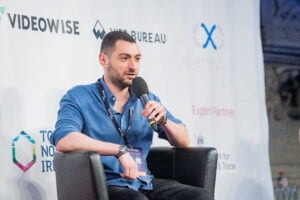Frederic Boyer, Head of New Business, makemepulse
Fantasized about for decades in science fiction movies, Augmented Reality (AR) is now within everybody’s reach…and already in almost every pocket.
It currently exists in the form of Snapchat Lenses, Facebook or Instagram effects, ARKit and ArCore. For a long time Virtual Reality (VR) was the ‘technology du jour’ which has seemed to have settled into the ultra-immersive games and entertainment world.
The real immersive reality experience revolution is totally led by AR, it’s the promise of a better future.
With at least 3 billion people having adopted this technology, and an estimated market value of $200 billion by 2025, AR is an open playing field for every industry from advertising to public services and includes video games, tourism, medicine and many more.
The AR revolution’s impact on marketing and advertising
AR is now considered to be a real communication medium, and a powerful tool for brands to use in their campaigns. It’s growth and awareness in marketing and advertising has been rapid.
The adoption of AR in entertainment, the importance of social media platforms using AR such Snapchat and Facebook, high quality AR applications available on Apple and Google smartphones or more experimental devices like Magic Leap or Microsoft Hololens have democratised the use of AR everywhere.
This technology is a real marketing revolution because it considerably enhances consumer experience and makes the buying decision far easier. It allows brands to offer their consumers a unique and super-personalised experience that is valuable to them and brands have already started to embrace the power of AR.
Retail transformation
Shopify released an AR option to directly experience its products in 3D at home so the consumer can interact with a product as a first step before buying. A study proved that “AR delivers exceptionally high attention levels – 45% higher than the average we see for TV viewing or general online browsing,” (Heather Andrew, CEO Neuro-Insight UK), and opened new perspectives for brands.
Ikea launched an AR app where consumers can see the item of furniture they’re thinking about buying in their own living-room, and see how it fits in with the rest of the room.
The fashion industry can also utilise AR to it’s advantage. Often criticized for its lack of environmental conscience, cheaper, faster fashion has come under fire not only for human rights abuses in sometimes third world supplier factories, but also it’s production process with dye and fabric.
AR can help keep the creative process alive by allowing consumers to virtually try on new shoes/clothes at home with a smartphone, and then order via the ecommerce website. In addition, we can develop drive-to-store strategies with an AR mirror to choose the jacket colour or style that fits best.
The combination of AR, 5G and AI will improve the consumer experience more than ever before. AT&T and the Dallas Cowboys proved it with an experience where the stadium came to life with 80ft football players, who were transported outside the stadium and onto the field using AR.
Throughout the game, players’ performance and statistics were enhanced and brought to life in augmented reality. AR literally moves sport shows to the next level, not only the game but the whole fan experience.
The future of AR in marketing and media is exciting and has the potential to be amplified by the IoT, AI or the power of 5G. Facebook and Ray-Ban recently announced a partnership to develop AR glasses, and Apple announced its AR Headset will be coming next year.
So to me, it seems that the AR revolution is just beginning. The creative and experiential possibilities are endless. I for one am so excited about the interactive and immersive experiences we can create…and how brands will embrace this revolution to connect with their customers in a more meaningful and valuable way.









